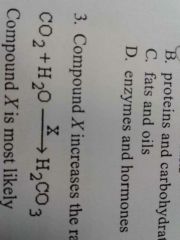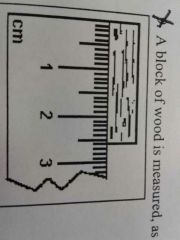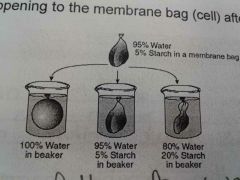![]()
![]()
![]()
Use LEFT and RIGHT arrow keys to navigate between flashcards;
Use UP and DOWN arrow keys to flip the card;
H to show hint;
A reads text to speech;
55 Cards in this Set
- Front
- Back

Which metabolism process is most closely associated with the organelle represented in the diagram? 1. Intracellular digestion 2. Cellular respiration 3. Synthesis of glycogen |
Cellular respiration |
|
|
Which substances are inorganic compounds? 1. Water and salts 2. Proteins and carbohydrates 3. Fats and oils 4. Enzymes and hormones |
Water and salts |
|

Compound X increases the rate of the reaction below. Compound X is most likely 1. An enzyme 2. A lipid molecule 3. An indicator 4. An ADP molecule |
An enzyme |
|
|
A green plant is kept in a brightly lighted area for 48 hours. What will most likely occur if the light intensity is then reduced slightly during the next 48 hours? 1. Photosynthesis will stop completely. 2. The rate at which oxygen is released from the plant will decrease 3. Glucose production inside each plant cell will increase 4.The rate at which nitrogen is used by the plant will increase. |
The rate at which oxygen is released from a plant will decrease |
|
|
Organisms that obtain and ingest organic molecules for their nutrition are classified as 1. Autotroph 2. Producers 3. Heterotroph |
Heterotroph |
|
|
Which laboratory equipment is correctly paired with a unit it measures? 1. Metric ruler - Centigrams 2. Celsius thermometer - degrees Fahrenheit 3. Graduated cylinder - milliliters |
Graduated cylinder - millimeters |
|
|
A student use some cheek cells under low power. Before switching to high power, the student should 1. Adjust the eyepiece 2. center the image being viewed 3. remove the slide from the stage 4. Remove the cover slip |
Center the image being viewed |
|

A block of wood is measured as shown in the diagram below. What is the length of the wooden block in millimeters? 1. 2.60 mm 2. 26.0 mm 3. 260 mm |
26.0 mm |
|
|
Which process requires cellular energy? 1. Diffusion 2. Passive transport 3. active transport 4. Osmosis |
Active transport |
|
|
What is the direct result of anaerobic respiration? 1. The potential energy of glucose is transferred to ATP molecules 2. The enzymes for anaerobic respiration are produced and stored in lysosomes 3. Lactic acid is produced in muscle tissue 4. Alcohol is produced by yeast and bacteria |
The potential energy of glucose is transferred to ATP molecules |
|
|
On the pH scale which numbers are acidic? |
0-6 |
|
|
On the pH scale which numbers are basic? |
8 - 14 |
|
|
On the pH scale which numbers are neutral? |
7 |
|
|
Absorption and distribution throughout an organism |
Transport |
|
|
Process that involves obtaining and processing materials like food. Eat, digest, Eliminate. |
Nutrition |
|
|
It makes it own food. Photosynthesis - plant/ producer |
Autotroph |
|
|
It gets its own food from other organisms in the environment |
Heterotroph |
|
|
What happens to the energy in glucose molecules during the process of cellular respiration? ( where does it go? What does it becomes?) |
ATP |
|
|
All the chemical reactions that occur in an organism. Some reactions are synthesis and they build molecules. |
Digestion |
|
|
Are decomposers heterotrophs or autotrophs? |
All decomposers are heterotrophs |
|
|
Maintaining a stable internal environment |
Homeostasis |
|
|
What happens if homeostasis is disrupted? |
An organism cannot survive |
|
|
How many millimeters are in 1 cm? |
10 |
|
|
Molecules containing both carbon and hydrogen |
Organic compounds |
|
|
Molecules that do not contain both carbon and hydrogen but contain H2O |
inorganic compounds |
|

Explain what is happening to the membrane bag after it is placed in each of the beakers. |
A. The bag expands because the water diffuses into the bag |
|
|
What happens at scene B? |
it stays the same at equilibrium |
|
|
What happened at scene C? |
The bag shrinks will water diffuses out of the bag |
|

What is the process below called? |
Dehydration synthesis |
|
|
What is the reverse of this process called |
Hydrolysis digestion |
|
|
Which organelles is aerobic cellular respiration occur in? |
The mitochondria |
|
|
Which organelle does photosynthesis occur in? |
Chloroplast |
|
|
What is the difference between a hypothesis and a theory? |
A hypothesis is a possible answer to a scientific question. a theory is a unified explanation for a set of observations |
|
|
Which one are you testing in a scientific investigation? |
Hypothesis |
|
|
What is a control group? |
The group that doesn't get the variable being tested. |
|
|
What is dichotomus key used for? |
to identify the genus and species of an organism |
|
|
What does active transport require that passive transport does not? |
Energy and ATP |
|
|
What do we call the pocket or groove on the surface of an enzyme where substrate fits in? |
the active site |
|
|
Why don't enzymes function if the shape of active site is altered and changed? |
Because the substrate will not fit into the active site |
|
|
What are some conditions that can cause enzymes to denature? |
Temperature and pH |
|
|
Describe the difference between the fine and coarse adjustment of a microscope. |
Coarse focus is used when first focusing. Fine focus is a sharp Focus. |
|
|
What is the diaphragm on a microscope used for? |
It controls the amount of light to hit the specimen |
|
|
Place these from simple to complex
Organ, tissue, cell, organelles, organ systems |
Organelle, cell, tissue, organ, organ system |
|
|
Which is a true statement about the relationship between pH and enzyme action? 1. All enzymes work best at a neutral pH 2. Adding more acid does not not affect the rate of activity of an enzyme 3. Enzymes function only in a PH range of 4.0 to 5.5 4. the activity of an enzyme is affected by pH |
The activity of an enzyme is affected by pH |
|
|
Which activity occurs in the process of photosynthesis? 1. Chemical energy from organic molecules is converted into light energy 2. organic molecules are exchanged from the environment 3. Organic molecules are converted into organic food molecules 4. Light energy is converted into the chemical energy of organic molecules |
Light energy is converted into the chemical energy of organic molecules |
|
|
The process of osmosis explain the net movement of water into a cell if the percentage of 1. Water was 90% inside the cell and 95% outside the cell 2. Protein one 30% inside the cell and 35% outside the cell 3. water was 95% inside the cell and 90% outside the cell |
Water was 90% inside the cell and 95% outside the cell |
|
|
Small molecules are combined to form large molecules by the life function of 1. Regulation 2. Excretion 3. Synthesis |
Synthesis |
|
|
Which process is not included in heterotrophic nutrition? 1. Ingestion 2. Photosynthesis 3. egestion |
Photosynthesis |
|
|
when viewed with a compound light microscope under low power, the letter 'p' will appear as 1. q 2. p 3. d |
d |
|
|
What is the basic unit of structure and function in all living cells? 1. cell 2. tissue 3. organ |
cell |
|
|
Which organism is classified as a heterotroph? 1. Mushroom 2. maple tree 3. moss |
mushroom |
|
|
Which substance is needed for aerobic cellular respiration to occur? 1.oxygen 2. carbon dioxide 3. methane |
oxygen |
|
|
The process of active transport requires the most direct use of 1. carbon dioxide 2. amino acids 3. ATP |
ATP |
|
|
The substance labeled catalyst is known as 1. a hormone 2. an enzyme 3. an antibody |
An enzyme |
|
|
These organisms carry out the activities needed to maintain homeostasis by using specialized internal 1. tissues 2. oragnelles 3. systems |
oragnelles |

